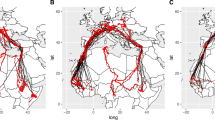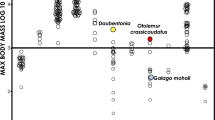Abstract
Most bird species will defend a territory during the breeding period to assure the availability of resources for their reproductive success. Migratory birds abdicate their territory ownership during the non-breeding period, posing a challenge for the following breeding season. Here we investigated the territorial behavior of male Lined Seedeaters Sporophila lineola, an intra-tropical migrant, during the breeding season (December–May) 2018/2019 in south-eastern Brazil. The Lined Seedeater is a sexually color-dimorphic species that inhabits open areas and feeds on seeds. We followed 18 color-banded individuals, during the period in which they had an active nest. For each individual, we recorded the locations in which they exhibited any potential territorial behavior, with the aid of a handheld GPS. We then estimated the size and shape of the territories using a Kernel Density Estimator. The breeding territories had on average 0.59 ± 0.24 ha, ranging from 0.21 to 0.91 ha in area. Males exhibited agonistic behavior whenever another male intrudes on their territories, especially if in the vicinity of their nests. Our observations indicate that male Lined Seedeaters defend small territories of exclusive use during the breeding season, but forage over a wider home range shared with other conspecifics. Therefore, Lined Seedeaters and other members of Sporophila seem to exhibit home ranges that are much larger than their breeding territories. Empirical studies are needed to understand the influence of territory size and quality on reproductive fitness.


Similar content being viewed by others
Availability of data and material
The raw data with all localities are available at a separate file (.xlsx).
References
Alcock J (2016) Avian mating and social behavior. In: Lovette IJ, Fitzpatrick JW (eds) Handbook of bird biology, 3rd edn. The Cornell Lab of Ornithology, Ithaca, pp 313–353
Areta JI, Bodrati A, Thom G, Rupp AE, Velazquez M, Holzmann I, Carrano E, Zimmermann CE (2013) Natural history, distribution, and conservation of two nomadic Sporophila seedeaters specializing on bamboo in the Atlantic Forest. Condor 115:237–252. https://doi.org/10.1525/cond.2013.120064
Barg JJ, Jones J, Robertson RJ (2005) Describing breeding territories of migratory passerines: suggestions for sampling, choice of estimator, and delineation of core areas. J Anim Ecol 74:139–149. https://doi.org/10.1111/j.1365-2656.2004.00906.x
Duca C, Marini MÂ (2014) Territorial system and adult dispersal in a cooperative-breeding tanager. Auk 131:32–40. https://doi.org/10.1642/AUK-13-005.1
Ferreira DF (2019) Atraso na maturação da plumagem em Sporophila (Aves: Thraupidae). MSc. Dissertation, Universidade Federal de Viçosa
Ferreira DF, Lopes LE (2017) Natural history of the Lined Seedeater Sporophila lineola (Aves: Thraupidae) in southeastern Brazil. J Nat Hist 51:1425–1435. https://doi.org/10.1080/00222933.2017.1319518
Francisco MR (2006) Breeding biology of the Double-collared Seedeater (Sporophila caerulescens). Wilson J Ornithol 118:85–90. https://doi.org/10.1676/1559-4491(2006)118[0085:BBOTDS]2.0.CO;2
Franz I, Fontana C (2013) Breeding biology of the Tawny-bellied Seedeater (Sporophila hypoxantha) in southern Brazilian upland grasslands. Wilson J Ornithol 125:280–292. https://doi.org/10.1676/12-059.1
Greenberg R (1986) Competition in migrant birds in the nonbreeding season. In: Johnston RF (ed) Current ornithology, vol 3. Springer. US, Boston, pp 281–307
Greenberg R, Gradwohl J (1997) Territoriality, adult survival, and dispersal in the Checker-throated Antwren in Panama. J Avian Biol 28:103–110. https://doi.org/10.2307/3677303
Haverschmidt F (1968) Birds of Surinam. Oliver and Boyd, Edinburgh
Hawkins GL, Hill GE, Mercadante A (2012) Delayed plumage maturation and delayed reproductive investment in birds. Biol Rev 87:257–274. https://doi.org/10.1111/j.1469-185X.2011.00193.x
Hinde A (1956) The biological significance of the territories of birds. Ibis 98:340–369. https://doi.org/10.1111/j.1474-919X.1956.tb01419.x
IBGE (2004) Mapa de biomas do Brasil: primeira aproximação. Ministério do Meio Ambiente, Instituto Brasileiro de Geografia e Estatística, Brasília
Laver P, Kelly M (2010) A critical review of home range studies. J Wildl Manag 72:290–298. https://doi.org/10.2193/2005-589
Lobato E, Moreno J, Merino S et al (2010) Arrival date and territorial behavior are associated with corticosterone metabolite levels in a migratory bird. J Ornithol 151:587–597. https://doi.org/10.1007/s10336-009-0488-x
Lopes LE, Marçal BF (2016) Avifauna do Campus Florestal da Universidade Federal de Viçosa, Minas Gerais, Brasil. Atual Ornitol 193:41–56
Lopes LE, Marini MÂ (2006) Home range and habitat use by Suiriri affinis and Suiriri islerorum (Aves: Tyrannidae) in the central Brazilian Cerrado. Stud Neotrop Fauna Environ 41:87–92. https://doi.org/10.1080/01650520500309826
Maher CR, Lott DF (1995) Definitions of territoriality used in the study of variation in vertebrate spacing systems. Anim Behav 49:1581–1597. https://doi.org/10.1016/0003-3472(95)90080-2
Oliveira L, Sousa L, Davanço PV, Francisco M (2010) Breeding behaviour of the Lined Seedeater (Sporophila lineola) in southeastern Brazil. Ornitol Neotrop 21:251–261
Powell R (2000) Animal home ranges and territories and home range estimators. In: Pearl M, Boitani L, Fuller T (eds) Research techniques in animal ecology: controversies and consequences. Columbia University Press, New York, pp 65–110. https://doi.org/10.7312/boit11340.9
Repenning M (2012) História natural, com ênfase na biologia reprodutiva, de uma população migratória de Sporophila aff. plumbea (Aves, Emberizidae) do sul do Brasil. MSc. Dissertation, Pontifícia Universidade Católica do Rio Grande do Sul
Repenning M, Fontana CS (2016) Breeding biology of the Tropeiro Seedeater (Sporophila beltoni). Auk 133:484–496. https://doi.org/10.1642/AUK-15-226.1
Ridgely RS, Tudor G (2009) Field guide to the songbirds of South America: the passerines. University of Texas Press, Texas
Rosoni JRR, Krügel MM, Fontana CS, Behr ER (2019) Território reprodutivo do Coleiro-do-brejo (Sporophila collaris) no sul do Brasil: seleção e descrição de áreas de nidificação e alimentação. Ornitol Neotrop 30:33–43
Rovedder CE (2011) História natural de Sporophila melanogaster (Pelzeln 1870) (Aves: Emberizidae) com ênfase em sua biologia reprodutiva. MSc. Dissertation, Pontifícia Universidade Católica do Rio Grande do Sul
Rovedder CE, Fontana CS (2012) Nest, eggs, and nest placement of the Brazilian endemic Black-bellied Seedeater Sporophila melanogaster. Wilson J Ornithol 124:173–176. https://doi.org/10.1676/10-182.1
Seaman DE, Millspaugh JJ, Kernohan BJ, Brundige GC, Raedeke KJ, Gitzen RA (1999) Effects of sample size on kernel home range estimates. J Wildl Manag 63:739–747. https://doi.org/10.2307/3802664
Sick H (1997) Ornitologia brasileira. Nova Fronteira, Rio de Janeiro
Signer J, Balkenhol N (2015) Reproducible home ranges (rhr): a new, user-friendly R package for analyses of wildlife telemetry data. Wildl Soc Bull 39:358–363. https://doi.org/10.1002/wsb.539
Silva JMC (1995) Seasonal distribution of the Lined Seedeater Sporophila lineola. Bull Br Ornithol Club 115:14–21
Stutchbury BJ, Morton ES (2001) Behavioral ecology of tropical birds. Academic Press, San Diego
R Core Team (2016) R: a language and environment for statistical computing. R Development Core Team, Vienna
Thomas BT (1979) The birds of a ranch in the Venezuelan Llanos. In: Eisenberg JF (ed) Vertebrate ecology in the northern Neotropics. Smithsonian Institution Press, Washington, DC, pp 213–232
Verner J (1977) On the adaptive significance of territoriality. Am Nat 111:769–775. https://doi.org/10.1086/283204
Welty JC, Baptista L (1988) The life of birds, 4th edn. Cengage Learning, New York
Acknowledgements
Currently, G. M. M. is a scholarship holder (132316/2020-0) from the Conselho Nacional de Desenvolvimento Científico e Tecnológico (CNPq) and previously received a scholarship from the same funding agency in the Programa Institucional de Bolsas de Iniciação Científica. CNPq which also awarded a research scholarship to L.E.L. (309660/2017-3). Wageningen University and Research and the Netherlands Institute of Ecology funded part of this study. Universidade Federal de Viçosa allowed us to conduct this study in the area under their care. Permits for this project were granted by Instituto Chico Mendes da Conservação da Biodiversidade (61078-1) and Comissão de Ética no Uso de Animais–Universidade Federal de Viçosa (03/2018). We thank the Lined Seedeater Project team for their help during data collection, especially Aléxa Silva, Aléxia Guimarães, Ana Maria Medeiros, Bárbara Couto, Dalila Ferreira, Gabriela Oliveira, Júlia Palhares, Lucas de Oliveira, Mayllin Lage, Melindy Dirks, Robert Benjamins, Tessa van de Bemt, Vinícius Nicolau, and Yvonne van de Weetering.
Funding
Gustavo de Melo Martins is a scholarship holder (132316/2020–0) from the Conselho Nacional de Desenvolvimento Científico e Tecnológico (CNPq). When the field data was collected, Gustavo was a scholarship holder for CNPq in the Programa Institucional de Bolsas de Iniciação Científica from UFV (PIBIC–UFV). Leonardo Esteves Lopes is also awarded a research scholarship from CNPq (309660/2017–3). The Lined Seedeater Project is financed by the Wageningen University and Research and the Netherlands Institute of Ecology.
Author information
Authors and Affiliations
Corresponding author
Ethics declarations
Ethics approval
Permits for this project were granted by Instituto Chico Mendes da Conservação da Biodiversidade (61078–1) and animal procedures were approved by the Comissão de Ética no Uso de Animais–Universidade Federal de Viçosa (03/2018).
Consent to participate
All the authors consent to participate in this study.
Consent for publication
All the authors consent to publish this study.
Conflict of interest
The authors declare no competing interests.
Additional information
Communicated by Cristiano Azevedo.
Supplementary Information
Below is the link to the electronic supplementary material.
Rights and permissions
About this article
Cite this article
Martins, G.d., Cunha, F.C.R. & Lopes, L.E. Territorial behavior of the migratory Lined Seedeater during the breeding season. Ornithol. Res. 29, 133–139 (2021). https://doi.org/10.1007/s43388-021-00065-y
Received:
Revised:
Accepted:
Published:
Issue Date:
DOI: https://doi.org/10.1007/s43388-021-00065-y




